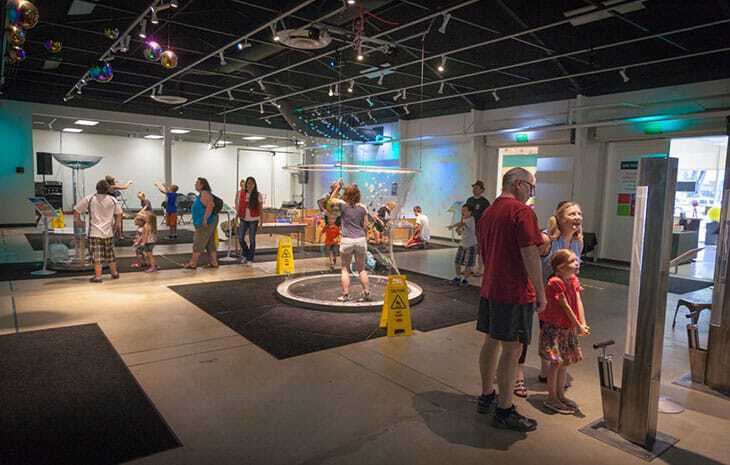
The pitch to the kids attending the science festival was simple—try this new app and comment on things you learned at the science festival.
The team making the pitch—members of the Maine Writing Project and Maine Discovery Museum—held their collective breath. This was the culmination of more than two years of trial and error in creating an immersive experience for teens that blended writing and science.
“You can post pictures, [share] your thoughts, and, if you want, learn about some of the exhibits around you,” the team stressed. Within a few hours they had given that pitch to dozens of youth. They got the idea, the adults were certain, but would they use it?
The partnership between a children’s museum in Bangor, Maine, and teachers of writing at the Maine Writing Project had begun two years earlier as part of the Intersections project. Inspired by a groundswell of interest in science sparked by Bangor’s inaugural Maine Science Festival in March 2015, the partners came together to see how they might capitalize on the enthusiasm to promote the natural connection between science and writing.
The group met regularly to plan their joint project, though not without some reservations.
“I can remember thinking that I wasn’t sure I could take on one more thing—away from campus, new people to deal with,” Ken Martin, director of the Maine Writing Project, said of the initial idea. “Niles, on the other hand, was excited about the idea,” he remembered.
“This was exactly what we were looking for,” Niles Parker, executive director of the museum, said. “As a children’s museum, we had become very insular in pursuing a narrow mission limited to serving kids ages 3-8 strictly within the museum walls. We wanted to knock those walls down and get outside the museum.”
Eventually, they settled on an app that kids could use to explore “science all around them.” They hired an app developer and began creating the content. The first app rolled out on Android devices in early 2015 and largely mimicked a classroom experience, with lots of text and prompts on specific aspects.
It bombed. The death knell came when the ninth-grade testers pronounced it “boring.”
Back at the drawing board, the team revamped the app entirely. At its heart, the new version was now about social sharing. The content would focus on four iconic Maine sites: Fort Knox, Orono’s Bog Walk, Mt. Katahdin, and the Penobscot River. Gone were the long explanations and lectures, replaced with mini articles on “mind-blowing” topics, as one of the teens put it. Teens could snap photos of what they saw and learned and share them, ask questions, and answer others—a “sort of Instagram for science,” Martin said.
“We wanted to knock those walls down and get outside the museum.”
Now, the day of reckoning had come. As the Intersections team waited, the kids took the app in hand and made it their own. Slowly their posts started to trickle in: a swarm of bees, then a 3-D printed heart. One teen added a photo of his buddy gripping a Van de Graaff generator, his hair wild with static electricity. Three girls snapped the neuroscience colorblind display.
The posts continued to roll in throughout the day: genetic vs. natural tomatoes, robotic arms, magnetic feats of wonder. Some focused on the science, and some focused on themselves, but the “kids showed what we’d hoped for,” said Martin, “that if you give youth an unstructured place to explore and comment on the things they are learning, then they will—sometimes in ways you don’t expect.”
Many kids treated the app like other social media, but some went further, posing questions to the discussion stream, which sometimes sparked other questions. The posts continued for days after the festival.
One user snapped the wispy clouds on the ride home. “Mare’s tails,” he noted, “foretelling a storm.” It snowed that night.
“Our little snowball was starting to roll,” said Martin. Altogether, there were nearly 800 posts from that weekend.
The team continues to collaborate and expand the app each year. They are also building a “Science Around ME” network. Educators and learners in both informal and formal settings are developing sites for the network. In 2016, three teachers were working with their students to create local, place-based sites. The two organizations continue to partner on other projects as well. The Maine Writing Project now holds its spring writing conference at the museum, and during summer 2016, the museum hosted a portion of the writing project’s WRITEscience Invitational Summer Institute.
The partnership gave shape to what was once only an idea—that writing projects and science-technology centers are natural partners for supporting discovery and learning by young people and their communities.
“Educators from formal and informal settings are an especially promising combination for integrating science and literacy,” the team wrote in its final report on the project.
Download the Science Around Me app (iPhone or iPad)
Try these starter prompts to get you started with the app

